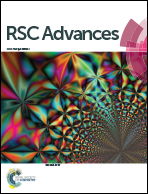Design, synthesis, characterization of some new 1,2,3-triazolyl chalcone derivatives as potential anti-microbial, anti-oxidant and anti-cancer agents via a Claisen–Schmidt reaction approach†
Abstract
The synthesis of a new series of (2E)-1-{1-[2,3-dichloro-6-methyl-5-(trifluoromethyl)phenyl]-5-methyl-1H-1,2,3-triazol-4-yl}-3-aryl prop-2-en-1-one (5a–k) and (2E)-1-{1-[2,3-dichloro-6-methyl-5-(trifluoromethyl)phenyl]-5-methyl-1H-1,2,3-triazol-4-yl}-3-(1,3-diaryl-1H-pyrazol-4-yl)prop-2-en-1-one (6a–e) were carried out via a Claisen–Schmidt condensation of 1-{1-[2,3-dichloro-6-methyl-5-(trifluoromethyl)phenyl]-5-methyl-1H-1,2,3-triazol-4-yl}ethanone (4) with different aryl and 1,3-diaryl-1H-pyrazole-4-carbaldehydes iii(a-e) in the presence of ethanol and aqueous sodium hydroxide mixture respectively. The newly synthesized compounds were characterized by IR, 1H NMR, 13C NMR, mass spectral data and elemental analysis. Further, they were screened for their in vitro anti-microbial, anti-oxidant and anti-cancer activities. Most of the synthesized compounds were displayed broad spectrum of anti-microbial, anti-oxidant activities and some of them exhibits moderate to excellent anti-cancer activities on breast cancer cell lines. Overall, this work has contributed to the development of promising leads for anti-microbial, anti-oxidant and anti-cancer activities.


 Please wait while we load your content...
Please wait while we load your content...